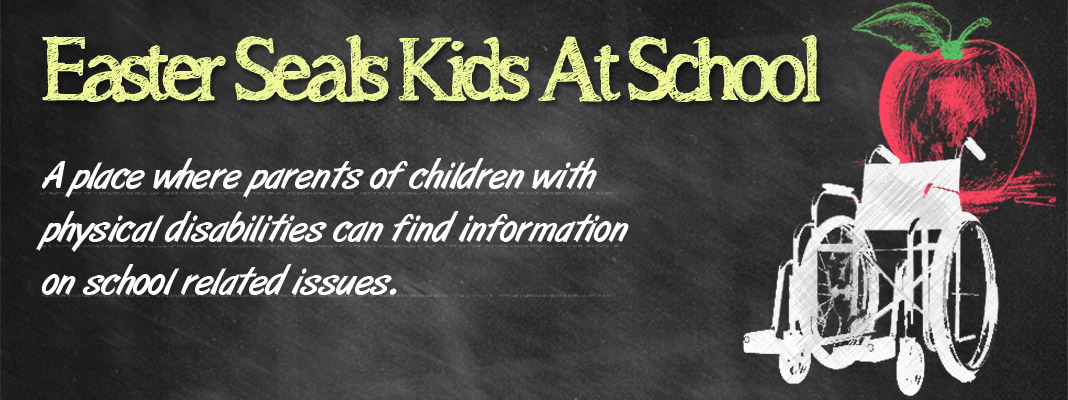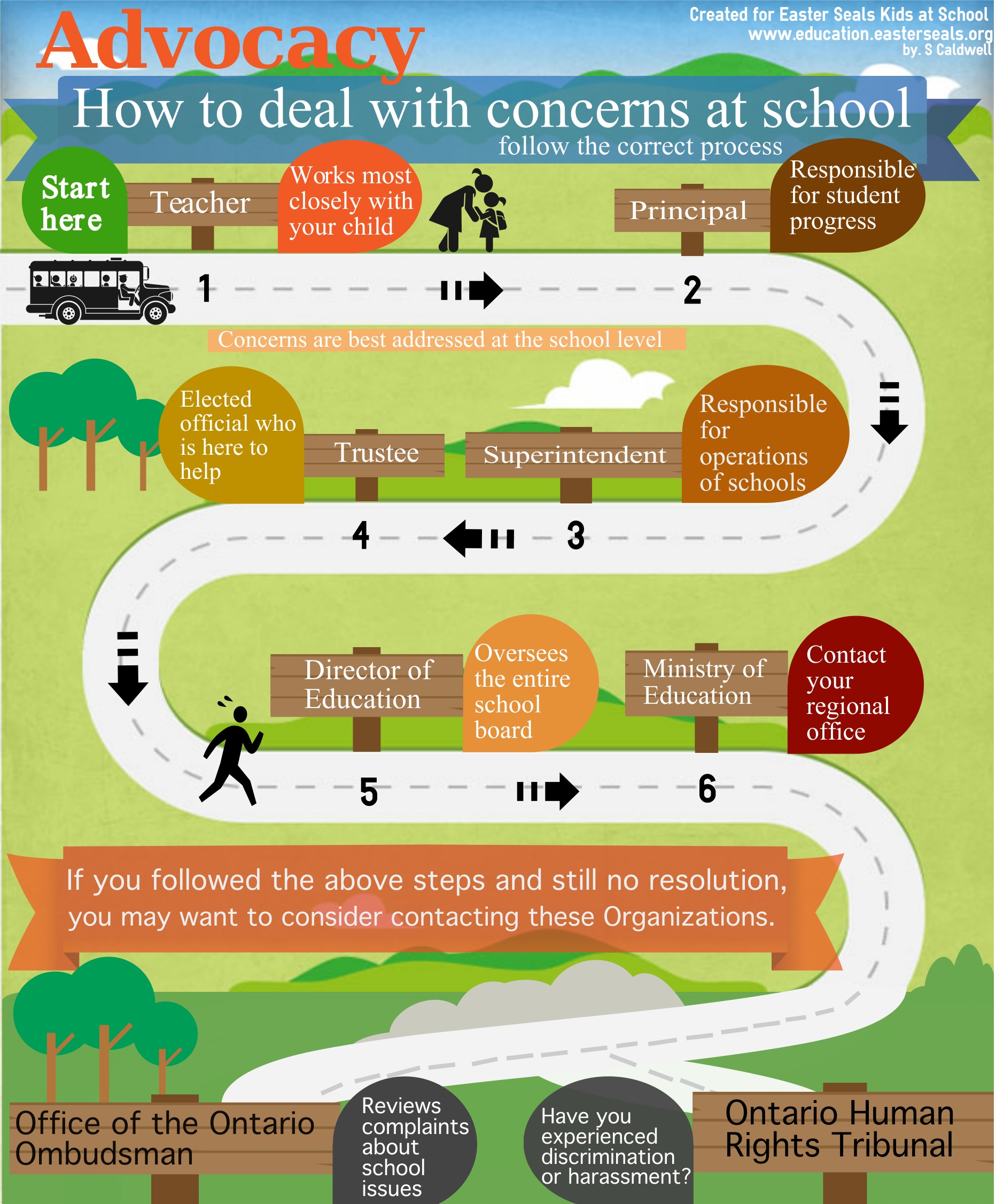As a parent, you have the right to voice your concerns to ensure that your child with disabilities is well-supported and successful at school. This article and the diagram above will provide you with the appropriate steps to take to present your concerns, whether big or small, via the ‘communication protocol.’
When you have a concern, we recommend that you start by recruiting help for your advocacy efforts. Talking about your child and problems at school can be an emotional process, therefore, it is a good idea to ask a family member or friend to help you plan your next steps. Together, you can figure out the best way to explain your concerns clearly and decide what type of solution to aim for. You can also seek help in the community by requesting support from other service providers who help your child, or advocacy organizations.
Once you’ve assembled your support system, you’re ready to take the first step in the communication protocol.
Step 1: Start with the Classroom Team (Teacher, Educational Assistant, or Early Childhood Educator)
Most problems can be resolved quickly and easily with open communication between the family and the class team, usually composed of a teacher, educational assistant, and/or an early childhood educator. It is important to talk about the issue or concern as soon as it arises with the person most involved. By keeping in regular contact with this person, a concern can be addressed in a casual conversation. With an open relationship, concerns can be discussed and ideas for solutions shared. This can lead to positive changes and ideally reduce or eliminate the problem.
Step 2: Connect with the Principal
The Principal is responsible for all of the students and staff at your child’s school. Depending on the size of the school, the Principal may be the next person that you talk to about your concern. If your child attends a large school, there may be additional staff you have the option of speaking to first, such as a special education teacher, a department head or Vice-Principal. If you’re unsure of who to reach out to next, the Principal can direct you to the correct person, or deal with the problem themselves.
For each new step in the communication protocol, it is recommended that you provide a summary of your previous attempts to resolve the issue (with the classroom team) including:
- dates of correspondence
- method of correspondence (in-person, email, via telephone) and
- the outcome (if any)
Step 3: Contact the Superintendent
School boards in Ontario vary in size and all have unique organizational structures. Most school boards have Superintendents who are responsible for groups of schools in a geographic area. Some school boards may also have a Principal or Superintendent responsible for special education. You can find out from the school staff, or by checking on the school board website the correct procedure (or ‘communication protocol’) for handling concerns. Once you know who the next person is, you can contact them and share your concerns. Remember to provide an updated summary of all previous attempts to resolve the issue with the school staff.
Step 4: Role of Trustees
Trustees are not able to resolve your concerns but they can provide valuable help in understanding the school system and directing you to the appropriate person. There are one or two elected Trustees for every area of the province and you can find out who your trustee is from the school board website. The Trustee is elected by the people and they are willing to help you.
Step 5: Involving the Director Education
The Director of Education is the boss and is responsible for all of the activities in the school board. If your concern has not been resolved by the school or superintendent, the Director of Education has the authority to arrange meetings and review your situation. Hopefully by this point, your concerns will be resolved, or the Director will identify another option for your family.
Step 6: Contacting the Ministry of Education
The Ministry of Education has regional offices across the province that are responsible for monitoring the school boards in their areas. While the Ministry of Education staff do not have the ability to resolve your concerns, they can help you navigate the system and encourage the school board to meet with you and discuss your concerns. Again, be sure to include a summary of your efforts to resolve the issue at all other steps in the communication protocol.
Concerns about Discrimination or Harassment
The Ontario Human Rights Commission is responsible for resolving concerns about discrimination and harassment based on violations of the Human Rights Code, including on the basis of disability. If at any point in the communication protocol you think your child has been discriminated against, you have the right to file a human rights complaint.
Individuals with disabilities are entitled to accommodations that enable them to participate in areas such as jobs, services and facilities, including public schools. The Ontario Human Rights Commission has developed a Consultation Paper: Education and Disability – Human Rights Issues in Ontario’s Education System. For more information on the Human Rights Code and how to file a human rights complaint, check the OHRC website.
Another Option – Ontario Ombudsman
The Ombudsman is an independent officer of the Legislature who investigates complaints from the public about Ontario government services, recommending improvements for governance and resolving individual issues. Since September 2015 the Ombudsman office has been able to look at individual issues related to school boards. For more information to and find out whether you can file a complaint check the Ombudsman website.
Legal Action
It is highly recommended that families make every attempt to resolve their concerns via the communication protocol before considering legal action. It may be worth contacting a lawyer to see if they can provide some free legal advice on your child’s circumstances, and doing so does not mean you have formally initiated the process of litigation.
The following resources may be helpful:
Summary and Final Tips:
- When you have a complaint or concern, keep records of everything you have done to try to resolve the issue. Provide this information at each new step in the communication protocol.
- Allow enough time before contacting the next step in the communication protocol. When asking for a response, provide a date and time by which you would like to hear back from the person.
- Record the names of people you have contacted including their job titles, the date you connected, and the response you were given. Organizing all of the information will make it easier at the next step and demonstrate the efforts you have made to resolve the issue.
This article does not discuss the process for dealing with disputes related to decisions of the Identification, Placement and Review Committee (IPRC) process. The process for appealing a decision of the IPRC is formalized through Regulation 181/98 and information for parents can be found on our blog.
Many thanks to Sherry Caldwell for the development of the graphic that accompanies this article.

